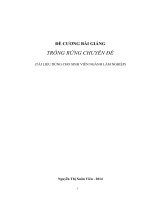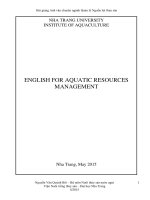unit 7 Bài giảng Anh văn chuyên ngành Tài chính Thư Viện Tài Liệu Tổng Hợp Com UNIT 7
Bạn đang xem bản rút gọn của tài liệu. Xem và tải ngay bản đầy đủ của tài liệu tại đây (351.12 KB, 8 trang )
7
AIMS:
Foreign exchange
To learn about: exchange rates; foreign exchange trading; key vocabulary of
exchange rates
To learn how to: talk about graphs and charts
To practise: describing a graph related to your work
Lead in
o How many different currencies can you name?
o How is the value (the exchange rate) of your currency determined?
o Has the exchange rate, compared to the US dollar or the euro, remained constant over
the last few years?
o Do you know the history of your currency over the past 50 years?
Reading 1: Exchange rates
Look at the time line below, showing key dates in the development of exchange rate systems
around the world. Match the dates with the events (a-e) below.
1944
1971 1973
1992
2002
1. Most industrialized countries switched to a system of floating rates. However, governments
and central banks occasionally attempted to influence exchange rates by intervening in the
markets. So there was a system of managed floating exchange rates.
2. The Bank of England lost over £5 billion in one day attempting to protect the value of the
pound sterling. After this, governments and central banks intervened much less, so there was
almost a freely floating system.
Unit 7: Foreign exchange
60
3. A fixed exchange rate system was started. The values of many major currencies were pegged
(or fixed) to the value of the US dollar. The American central bank, the Federal Reserve,
guaranteed that it could exchange an ounce of gold for $35.
4. Twelve states of the European Union introduced a single currency, the euro, to replace their
national currencies.
5. Gold convertibility ended because the Federal Reserve no longer had enough gold to back the
dollar, due to inflation.
Reading 2: Freely floating exchange rates
Peter Sinclair presents about the potential problems of freely floating exchange rates, and
answer the questions.
I think a lot of people would say that there's been an important trend towards more flexibility
in exchange rates. So, for example, the pound now floats freely in terms of other currencies, the
central bank doesn't intervene - only very, very rarely - and that's true for an increasing number of
countries .
... the market system is now doing, say in the case of sterling, what central banks and finance
ministries used to do in the past, which is trying to pick and stick to an appropriate level for the
currency. But there are problems with the markets: markets are not perfect. One problem is that
nobody knows the future and if there is an unexpected piece of news about a country, say you
discover a vast amount of oil or the government suddenly falls and is likely to be replaced by one
which has a very different financial, tax, or monetary policy, then everybody will suddenly wake
up and say, 'Hey this is a country whose currency we must buy lots of' or 'This is now really
unsafe, we must get out.' And the swings in exchange rates can be absolutely enormous, you can
see a currency go up or down by one, two, three percent maybe in a day, in response to certain
news.
... a lot of the people who are operating in foreign exchange markets don't tend to think so
much about the long run and what the currency really ought to be worth in order for its goods to be
priced at the right level in foreign markets and so on. They're trying to guess very short-term
trends, and they're trying to guess the hunches of other traders. They tend to say, 'Oh, let's see, if
something is going up today it will probably go up tomorrow.' They just go in one direction and
you often get huge exchange rate swings, going on for maybe even years, certainly for weeks and
months, which are pushing the currency away from what it really ought to be. This is a source of
worry and it's undoubtedly happening and it's due to the fact that people don't have perfect
Unit 7: Foreign exchange
61
information and often tend to say, 'Well, if he's doing this then he must know something I don't, I'd
better copy him', and that can be a recipe for real trouble.
1. What does Sinclair say is the current trend in exchange rates?
…………………………………………………………………………………………………………..
2. What examples does he give of unexpected pieces of news?
…………………………………………………………………………………………………………..
3. What can happen to currencies in response to unexpected news?
…………………………………………………………………………………………………………..
4. Why can currencies be at the wrong level for long periods of time?
…………………………………………………………………………………………………………..
Discussion
Has the value of the currency of your country risen or fallen in the past few weeks or
months? Do you know why?
What international events do you expect to affect exchange rates in the next few weeks or
months? Why and how?
How could you attempt to profit from these changes, if you had a large amount of cash at
your disposal?
Reading 3: Currency trading
1. You are going to read a text about online currency trading. Before you read, answer the
following questions.
1. Why do people buy and sell currencies?
…………………………………………………………………………………………………………..
2. What do you think the world's seven major currencies are?
…………………………………………………………………………………………………………..
2. Now read the text and - using your own words as much as possible - write seven
statements about the following figures:
a. 5%
e. 1,000,000,000,000
b. 30
f. 24
c. 85%
g. 95%
d. 2
Unit 7: Foreign exchange
62
3. Find the words in the text that mean the following:
1. the total amount of money spent in a
market
4. people who buy and sell things in the hope of
making a profit
2. another word for stocks and shares
5. easy to sell (to convert into cash)
3. belonging to one's own country
6. price change
Unit 7: Foreign exchange
63
Language focus
Describing trends and graphs
If we want to show changes in the value of a currency, trends in the economy or any other
quantities which change over time, we often use graphs. There are a number of commonly used
words and phrases to describe upward and downward movement, as well as the rate and size of the
change.
1. The phrases in the box are used to describe trends and graphs. Put them in the table
below, according to the word category. One has been done for you.
dramatic increase
gradual rise
rapid decline
fall sharply
level off
slight drop
gradually decrease
moderate growth
sudden climb
Speed
Size
Verbs
Nouns
2. Look at the graph showing the development of the USD/ GBP exchange rate and
complete the description using words and phrases from the box.
Unit 7: Foreign exchange
64
Choose the correct answer:
1. Employees’ and officers’ salaries, utility bills, stationery and office supplies are
…………….expenses
A. general and administrative
B. depreciation
C. selling
D. production
2. The purpose of cost accounting is to establish the ..........that ensures a profit
A. break-even point
B. selling price
C. standard cost
D. factory cost
3. ……………is a document requesting a supplier to deliver specified goods.
A. Purchase order
B. Store requisition slip C. Receiving report
D. Overhead
4. …………… is the portion of a corporation’s earnings paid to its stockholders.
A. Dividend
B. Share
C. Income
D. Benefit
5. ………… is the income that is not paid out by a business to its stockholders as dividends, often
used for investment or expansion.
A. Retained earning
B. Net income
C. EBT
D. Gross income
6. ……………. is an accounting function that involves the review and evaluation of financial
records.
A. Auditing
B. Budgeting
C. Costing
D. Taxing
7. Indicate which of the following item is a manufacturing business
A. Shoes shop
B. Dental practice
C. Travel agency
D. Sugar refinery
8. On 1st March, the company purchased a machine valued at $120,000 included VAT. A deposit
of $20,000 cash was paid and a mortgage loan obtained for the remaining. How many accounts
are affected by this transaction?
A. two accounts
B. three accounts
C. four accounts
D. five accounts
Unit 7: Foreign exchange
65
9. Which of the following items is not an example of current assets?
A. debtors
B. franchises
C. cash
10. ……….the pattern in which cash moves in and out of the firm.
A. Cash disbursement B. Cash expenditure
C. Cash flow
D. inventories
D. Cash receipt
New words:
− foreign exchange
: ngoại hối
− switch to (v)
: chuyển sang
− floating rate (n)
: mức thay đổi
− float (v)
: trôi lơ lửng
− occasionally (adv)
: thỉnh thoảng, đôi khi
− intervene
[,intə'vi:n]
(v)
: xen vào , can thiệp
− peg (v)
: ổn định (giá cả), đóng chốt
− federal reserve (n)
: Cục Dự Trữ Liên Bang
− ounce (n)
: đơn vị đo lường , = 28,35g
− European Union (n)
: Liên Minh Châu Âu
− replace (v)
: thay thế
− convertibility (n)
: việc có thể hoán đổi, thay đổi
− convert (v)
: đổi, biến đổi
− due to
: do bởi
− in response to
: hưởng ứng, đáp ứng
− flexibility (n)
: tính linh hoạt
− stick to
: bám vào, gắn bó với
− appropriate (adj)
: phù hợp
− swing (v)
: đung đưa
− swing (n)
: (giá cả) sự lên xuống đều đều
− enormous (adj)
: to lớn
− worth (adj)
: xứng đáng, đáng giá
− hunch (n)
: miếng to , linh cảm
− direction (n)
: hướng
− undoubted (adj)
: hoài nghi
− recipe (n)
: công thức
Unit 7: Foreign exchange
66
− disposal (n)
: việc bán, chuyển nhượng
− affect (v)
: ảnh hưởng
− turnover (n)
: doanh thu
− combined volume
: số lượng tổng hợp
− simultaneous (adj)
: đồng thời
− trillion
: nghìn tỷ
− speculator (n)
: người hay suy đoán, kẻ đầu cơ
− liquid (adj)
: (tiền) mặt
− fluctuation (n)
: sự dao động
− OTC market : over-the-counter market
: thị trường ngoài Sở giao dịch chứng khoán
= Outside market
− Interbank market
: thị trường liên ngân hàng
− conduct (v)
: thực hiện
− counterpart (n)
: bên đối tác
− centralize (v)
: tập trung
− via
: qua
− rapid (adj) = fast
:
− dramatic (adj)
: đáng kể
− moderate (adj)
: vừa phải
− slight (adj)
: nhẹ, mong manh
− sharply (adv)
: nhanh chóng , mau mắn, rõ ràng
− steadily (adv)
: đều đặn
− peak (v)
: đạt tới đỉnh cao nhất
− devalue (v)
: giảm giá trị, mất giá
− slide (v)
: trượt, chuyển động nhẹ nhàng
…………………………………………………………………………………………………………………………..
…………………………………………………………………………………………………………………………..
…………………………………………………………………………………………………………………………..
…………………………………………………………………………………………………………………………..
…………………………………………………………………………………………………………………………..
…………………………………………………………………………………………………………………………..
…………………………………………………………………………………………………………………………..
Unit 7: Foreign exchange
67









